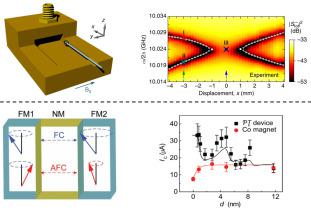当前位置:
X-MOL 学术
›
Phys. Rep.
›
论文详情
Our official English website, www.x-mol.net, welcomes your feedback! (Note: you will need to create a separate account there.)
Non-Hermitian topological magnonics
Physics Reports ( IF 30.0 ) Pub Date : 2024-02-09 , DOI: 10.1016/j.physrep.2024.01.006 Tao Yu , Ji Zou , Bowen Zeng , J.W. Rao , Ke Xia
Physics Reports ( IF 30.0 ) Pub Date : 2024-02-09 , DOI: 10.1016/j.physrep.2024.01.006 Tao Yu , Ji Zou , Bowen Zeng , J.W. Rao , Ke Xia

|
Dissipation in mechanics, optics, acoustics, and electronic circuits is nowadays recognized to be not always detrimental but can be exploited to achieve non-Hermitian topological phases or properties with functionalities for potential device applications, ranging from sensors with unprecedented sensitivity, energy funneling, wave isolators, non-reciprocal signal amplification, to dissipation induced phase transition. As elementary excitations of ordered magnetic moments that exist in various magnetic materials, magnons are the information carriers in magnonic devices with low-energy consumption for reprogrammable logic, non-reciprocal communication, and non-volatile memory functionalities. Non-Hermitian topological magnonics deals with the engineering of dissipation and/or gain for non-Hermitian topological phases or properties in magnets that are not achievable in the conventional Hermitian scenario, with associated functionalities cross-fertilized with their electronic, acoustic, optic, and mechanic counterparts, such as giant enhancement of magnonic frequency combs, magnon amplification, (quantum) sensing of the magnetic field with unprecedented sensitivity, magnon accumulation, and perfect absorption of microwaves. In this review article, we address the unified approach in constructing magnonic non-Hermitian Hamiltonian, introduce the basic non-Hermitian topological physics, and provide a comprehensive overview of the recent theoretical and experimental progress towards achieving distinct non-Hermitian topological phases or properties in magnonic devices, including exceptional points, exceptional nodal phases, non-Hermitian magnonic SSH model, and non-Hermitian skin effect. We emphasize the non-Hermitian Hamiltonian approach based on the Lindbladian or self-energy of the magnonic subsystem but address the physics beyond it as well, such as the crucial quantum jump effect in the quantum regime and non-Markovian dynamics. We provide a perspective for future opportunities and challenges before concluding this article.
中文翻译:

非厄米拓扑磁振子学
如今,机械、光学、声学和电子电路中的耗散被认为并不总是有害的,但可以用来实现非厄米拓扑相或特性,并具有潜在设备应用的功能,包括具有前所未有的灵敏度的传感器、能量漏斗、波隔离器、非互易信号放大、耗散引起的相变。作为存在于各种磁性材料中的有序磁矩的基本激发,磁振子是磁振子器件中的信息载体,具有低能耗,用于可重新编程逻辑、非互易通信和非易失性存储功能。非厄米拓扑磁振子学涉及非厄米拓扑相或磁体特性的耗散和/或增益工程,这些在传统厄米场景中是无法实现的,相关功能与其电子、声学、光学和机械对应物,例如磁振子频率梳的巨大增强、磁振子放大、以前所未有的灵敏度对磁场进行(量子)传感、磁振子积累和微波的完美吸收。在这篇综述文章中,我们讨论了构造波角非厄米哈密顿量的统一方法,介绍了基本的非厄米拓扑物理,并全面概述了在实现不同的非厄米拓扑相或性质方面的最新理论和实验进展。磁波设备,包括特异点、特异节点相位、非厄米特磁波 SSH 模型和非厄米集肤效应。我们强调基于林布拉德或波子子系统自能的非厄米哈密顿方法,但也解决了其之外的物理问题,例如量子体系中关键的量子跳跃效应和非马尔可夫动力学。在结束本文之前,我们对未来的机遇和挑战进行了展望。
更新日期:2024-02-09
中文翻译:

非厄米拓扑磁振子学
如今,机械、光学、声学和电子电路中的耗散被认为并不总是有害的,但可以用来实现非厄米拓扑相或特性,并具有潜在设备应用的功能,包括具有前所未有的灵敏度的传感器、能量漏斗、波隔离器、非互易信号放大、耗散引起的相变。作为存在于各种磁性材料中的有序磁矩的基本激发,磁振子是磁振子器件中的信息载体,具有低能耗,用于可重新编程逻辑、非互易通信和非易失性存储功能。非厄米拓扑磁振子学涉及非厄米拓扑相或磁体特性的耗散和/或增益工程,这些在传统厄米场景中是无法实现的,相关功能与其电子、声学、光学和机械对应物,例如磁振子频率梳的巨大增强、磁振子放大、以前所未有的灵敏度对磁场进行(量子)传感、磁振子积累和微波的完美吸收。在这篇综述文章中,我们讨论了构造波角非厄米哈密顿量的统一方法,介绍了基本的非厄米拓扑物理,并全面概述了在实现不同的非厄米拓扑相或性质方面的最新理论和实验进展。磁波设备,包括特异点、特异节点相位、非厄米特磁波 SSH 模型和非厄米集肤效应。我们强调基于林布拉德或波子子系统自能的非厄米哈密顿方法,但也解决了其之外的物理问题,例如量子体系中关键的量子跳跃效应和非马尔可夫动力学。在结束本文之前,我们对未来的机遇和挑战进行了展望。



























 京公网安备 11010802027423号
京公网安备 11010802027423号